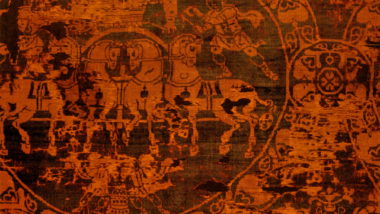
Image by/from Giuseppe Enrie, 1931
The Shroud of Turin Research Project (often abbreviated as STURP) refers to a team of scientists which performed a set of experiments and analyses on the Shroud of Turin during the late 1970s and early 1980s. STURP issued its final report in 1981.
Joe Nickell of the Committee for Skeptical Inquiry has pointed out that “STURP’s leaders served on the executive council of the Holy Shroud Guild, which is devoted to the “cause” of the reputed relic.”
The origins of the group go back to the experiments of physicist John P. Jackson, thermodynamicist Eric Jumper and photographer William Mottern in 1976. Using the ideas invented in aerospace science for building three dimensional models from images of Mars, Eric Jumper built initial devices to test the photographs of the Shroud of Turin. These were the first experiments relating to the shroud performed by scientists.
In March 1977, Jackson, Jumper and Mottern invited a few other scientists to join them to form a team for the analysis of the Shroud. The first meeting took place in Albuquerque, New Mexico. The group had no official sponsorship and the scientists funded their own activities. They also managed to arrange gifts and loans of technical equipment whose value was estimated at over $2 million.
Nuclear physicist Tom D’Muhala headed STURP. Apart from Jackson, Jumper, and Motten the team included thermal chemist Raymond N. Rogers, and Ron London, and Roger Morris, all from Los Alamos National Laboratory. Other team members included Don Lynn of the Jet Propulsion Laboratory in Pasadena, biophysicist John Heller, photographers Vern Miller and Barrie Schwortz, optical physicist Sam Pellicori, and electric power experts John D. German and Rudy Dichtl, as well as forensic pathologist Robert Bucklin. STURP included no experts on medieval art, archaeology, or textiles.
To commemorate the 400th anniversary of the arrival of the shroud in Turin, it was displayed to the public in Turin from 27 August to 8 October 1978, with about 3 million visitors attending the exposition under bullet-proof glass. For the next 5 days after the exposition the STURP team analyzed the shroud around the clock at the royal palace adjoining Turin Cathedral, some scientists sleeping while others worked. A team of European scientists headed by Luigi Gonella supervised the activities. The team gathered sticky tape samples of material from several points on the surface of the shroud.
STURP team members continued their research after access to the shroud and published many of theirs results in scientific journals and proceedings. In 1981, in its final report, STURP wrote:
“We can conclude for now that the Shroud image is that of a real human form of a scourged, crucified man. It is not the product of an artist. The blood stains are composed of hemoglobin and also give a positive test for serum albumin. The image is an ongoing mystery and until further chemical studies are made, perhaps by this group of scientists, or perhaps by some scientists in the future, the problem remains unsolved.”
It is to be noted that in the Catholic liturgy, there is the phrase “the mystery of faith”. The resurrection is a mystery to which there is no precendent. However, all other attempts to explain it away fail.
1. There is agreement that Jesus was crucified.
2. There are those who said that Jesus was not really, fully dead when
he was buried.
In that case, the Roman soldiers lives’ would have been at risk in
two regards.
a. for not making sure Jesus was dead and
b. for letting a live Jesus escape a tomb they were supposed to
guard to make sure he did not escape
3. If Jesus was not fully dead, and only “swooned” or “fainted”, how
did he have the strength to roll a multi-ton stone away from the
the mouth of the tomb? Plus, a few hours earlier, he did not have
the strength to carry his cross. How was he stronger after a
crucifixion than before it?
4. Why did Jesus’ followers all testify to a risen Christ? They did
not testify of a Christ who appeared them beaten and bloody.
5. Many of the Apostles and disciples were martyred and died for their
faith. People sometimes do pranks and jokes. No one is will to
take a prank or joke so far that they die for it.
Jesus rose from the dead. Jesus Christ is alive today. Truly, it is a mystery of faith, but if individuals believe in their heart that Jesus rose from the dead, and confess Him as Lord, they will be saved, born again, and realize the reality of Jesus’ resurrection for themselves.
Source: https://en.wikipedia.org/wiki/Shroud_of_Turin_Research_Project
If you like this blog, please link to it or share the link with others. Thank you.
